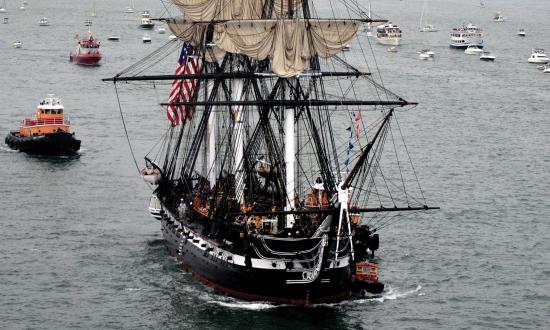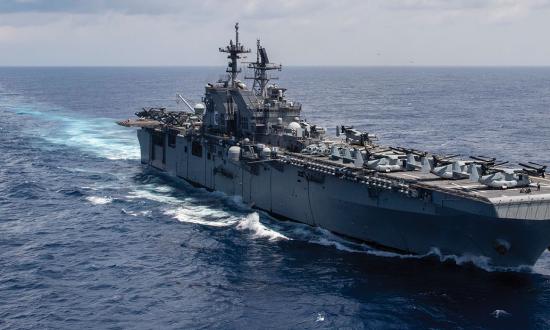The Marine Corps’ Dangerous Shift to Defense
The expeditionary advanced base operations (EABO) concept applies maneuver warfare to support the Navy in achieving sea control. It is not prescriptive in terms of offense or defense, though it certainly requires an offensive mind-set and aggressive exploitation of opportunities. The idea is to fight from a position of advantage in the context of the proliferation of mobile, long-range precision missiles. Max Hastings noted “the tactical weakness of the Americans” in his Vietnam War history: “they made themselves visible, vulnerable targets, while the enemy seldom did so.” During the past decade, the Navy and Marine Corps have gradually accepted this and concluded that the answer for the fleet is maneuver. Maneuver to achieve sea control means fighting at a time and place of our choosing. Speed and tempo are essential, making smaller, lightweight, mobile forces imperative. Because of the missile threat, we have to spread out. We have to make ourselves less vulnerable.
Understanding the basics of EABO does not require access to the classified versions of the handbook; concept documents and authoritative sources are available publicly. For the strategic context, start with Advantage at Sea: Prevailing with Integrated All-Domain Naval Power, the tri-service maritime strategy issued in December 2020. Fleet Tactics and Naval Operations influenced the development of EABO, promulgating the great naval maxim of tactics: attack effectively first. Other essential reading includes the Marine Corps’ Littoral Operations in a Contested Environment (LOCE) and General David H. Berger’s writings on EABO, including his Commandant’s Planning Guidance. The Tentative Manual for Expeditionary Advanced Base Operations is available at the Marine Corps Warfighting Lab’s website. It is impossible to conclude from these readings that EABO calls for a shift to the defense. As a whole, they call for seizing the initiative and confronting aggression. This applies equally to tactical defense and offense. EABO exhorts leaders to develop and exploit opportunities through bold action, regardless of the tactical situation.
—LtCol Herbert J. Bowsher, USMC, CO, Marine Air Support Squadron 6
I agree with Captain McGee that more rigorous study is needed before determining that contemporary defense is superior to offense in littoral combat. But pacing threats that can conduct offensive operations against U.S. forces mandate a renewed focus on tactical and operational defense led by the Marine Corps. After the Soviet Navy ceased to be a credible maritime threat, the Corps concentrated on the offense by exploiting the Navy’s supremacy on the high seas. JP 3-18, Joint Forced Entry Operations, is a prime example of this offensive-focused mind-set. The document implores planners to solve the tactical and logistical difficulties in establishing and expanding a lodgment (a beach head).
JP 3-18 recognizes the danger of area-denial attacks, but quickly transitions to considerations for expanding the lodgment. This suggests planners think it unlikely that an enemy can incapacitate an offensive operation before it can create a lodgment. Offensively focused documents such as JP 3-18 seem to presume that antiaccess/area-denial weapons are mitigable risks, and that the U.S. military will be on the offense all day, every day. This too is a dangerous assumption.
Tactical and operational defense by some units does not relegate the Marine Corps to a purely defensive role. Instead, effective, elastic defense is the cornerstone to the counter-offense. EABs that hold, delay, and attrite hostile naval forces drive an opponent’s maritime force into a premature culmination point, enabling a concentrated naval task force to deliver a decisive counterattack.
It is uncertain whether offense or defense will have the upper hand in contemporary littoral combat. It is prudent to invest in both, and the current defensive focus of EAB operations is necessary to balance the Corps’ capabilities. To my knowledge, we do not have a defensive doctrine equivalent to JP 3-18 in holding and defending the maritime domain or long-established offense-focused units such as the Marine air-ground task force. The focus on maritime defense does not undermine the role of offense, but builds a Marine Corps that can win—whether on the offense or the defense.
—LT(jg) Jeong Soo Kim, USN
Design the Littoral Combat Team Around Its Core Mission
An EABO operating under the nose of an enemy in an environment of “contested logistics” makes me think of Britain’s World War II Singapore strategy and the fate of ground forces cut off from logistical support, operating without air and sea control. The Singapore strategy specified fortification of the Royal Navy base so it could hold out until the fleet arrived. It is similar to EABO in that a static military unit was supposed to be able to fill in for the fleet in the sea-control mission. Britain never funded the Singapore defenses to the required levels, but it did have what was considered the ultimate antiship weapon of its day in 15-inch gun batteries and also aircraft. The British guns were sited to repel an attack from the sea, but the Japanese attacked from the overland route deemed by Britain as impossible. The Commonwealth army surrendered one-third its number to the Japanese army because Japan controlled the sea and air, and continued logistical support was impossible.
The initial Japanese offensive was a joint operation that conquered the Allied ground and air forces in the Pacific, including a large ground force in the Philippines and smaller garrisons at Wake Island and Guam. After control of the air and sea were lost, the ground forces had no chance of holding out. The Japanese offensive that coordinated air, ground, and naval force in a campaign ranging thousands of miles is more impressive than the more well-known blitzkrieg.
The 1942–45 U.S. island-hopping strategy across the Pacific cut off and left behind the largest, most well-defended islands, such as Truk, Formosa, and Rabaul. Airstrikes destroyed enemy air forces, without which the garrisons had neither the mobility nor the strike capacity to influence events. The islands were effectively converted into prison camps without fences.
Guadalcanal can be seen as exemplifying a successful EABO because the United States controlled the air and sea by day and funneled in tactical aircraft. Guadalcanal was a failed EABO for Japan, because its lack of control of the air and sea, except at night, prevented the island from being a base from which to strike at U.S. aircraft or shipping.
How can an EABO in a “contested” environment perform sustained sea control if operating with reduced or “austere” logistical support? How would the Navy withdraw the EABO if unable to provide logistical support when its own resources, due to losses, were inadequate? Would the Marines be abandoned, as were World War II ground forces? If carrier strike groups are vulnerable to ballistic missiles, how is an EABO less so? If the United States has control of the sea by traditional naval and air forces, what does a less-mobile EABO add to the equation, and at what cost in U.S. mobility and required logistical support?
—LCDR Tim Stipp, USNR
This article is of great importance today. A short sea story comes to mind: In 1967 during the Vietnam War, Kaoshiung, Taiwan, was an upkeep and liberty port for the Navy. The harbor is well protected and large. Three or four destroyers were moored alongside an AR [repair ship], as was the USS Tutuila (ARG-4). The AR’s commanding officer was SOPA [senior officer present afloat] (0-6). A typhoon from the Philippine Islands developed and was tracking toward Taiwan. SOPA ordered all Navy ships to sea as several Nationalist Chinese Navy ships were returning to port. I was CO of the former Liberty ship Tutuila, and lost a request to remain in port. Once at sea, the Tutuila took a beating in the shallower waters toward the mainland. Following some bad rolls, I decided to return to port. Offshore several hours later, I requested permission to enter port from the Chinese. We received a PERGRA [permission granted], entered port, and moored to the assigned buoy, with the weather much improved from being in the Taiwan Strait approaches. A short time later, a destroyer requested permission to enter port from SOPA, on harbor voice radio. As the only Navy ship in port I had become SOPA, and of course approved the request. The destroyer happened to be commanded by a classmate senior to me and good friend, William P. St. Lawrence. He brought his destroyer alongside to port in about five minutes (an outstanding landing with gale, gusting winds subsiding). About 15 minutes later, I heard from the destroyer’s 1MC, “liberty call.” My executive officer then recommended that we should announce liberty, which had been canceled before we got underway.
Captain St. Lawrence was indeed one smart, very capable naval officer. We had a short reunion. The Tutuila had several more days of scheduled upkeep, and I did not care to return to Vietnam early.
—CAPT Lawrence P. Treadwell, USN (Ret.), Golden Life Member
Military Leadership Requires Good Citizenship
White Officers: Maybe Oblivious But Not Innocent
We Don’t Need Conversations, We Need Systemic Change
When Commander Johnson writes of overwhelming whiteness in U.S. military leadership, the implication is that all whiteness is the same, whether of Swedish, German, or Greek origin— anything not Black or Hispanic. But Argentinians are largely Italian (which in the United States falls under “white”) and speak Spanish (Hispanic, hence “not white”). Where do they fit in? And Brazilians of German descent speaking Portuguese, or “white” Greeks in Turkey? The 8th Air Force that stomped Hitler’s Luftwaffe did not look at such statistics, nor did the Marines who won the Pacific. Along with exceptional leadership and home-front support, the deciding factors were luck, talent, competence, performance, and ambition.
Today, by contrast, it seems that competence and performance take a backseat to social engineering and a social-justice ethos. Instead of cultural self-flagellation, we should be focusing on how to win wars and be ready for them.
—Paul Cavallo
Challenging the Conventional: Diversity Deserves Better
Lieutenant McKinney makes several good points and shows how institutional bias, today likely unintended, unfortunately still exists. He refers to the May issues of Proceedings, which every year provide photographs of all the flag and general officers of the naval services. I joined the Naval Institute in 1965 and am a Life Member, and I cannot say these past 56 years have brought orders of magnitude of progress in inclusivity and diversity. Granted, there has been improvement—but not nearly enough, especially in the senior officer ranks.
While the general thrust of Lieutenant McKinney’s essay is, therefore, unimpeachable, his premise that the Declaration of Independence established all men as equals is not entirely accurate. That statement was written by Thomas Jefferson, deservedly one of the most revered founding fathers and a very knowledgeable Enlightenment scholar—who had his issues. More important is the Constitution’s Article 1, Section 2, concerning the House of Representatives, which “shall be apportioned among the several States . . . according to their respective Numbers, which shall be determined by adding the whole Number of free Persons . . . and excluding Indians not taxed, three-fifths of all other persons,” meaning slaves.
To be rid of this legacy, it took four years of Civil War and more than half a million Americans killed; the Emancipation Proclamation of 1863; the 13th, 14th and 15th Amendments adopted between 1865 and 1870, which abolished slavery, granted citizenship to the former slaves, and confirmed their right to vote (deleting in this way the above phrase from Article 1); and the 19th Amendment which granted women the right to vote.
But all this was not enough. President Harry S. Truman issued Executive Order 9981 in 1948 to desegregate the armed forces, which took six years to be fully implemented. The Supreme Court, with its 1954 Brown vs. Board of Education decision, also weighed in against racial discrimination, as did Congress in 1964 (the Civil Rights Act) and 1965 (the Voting Rights Act). In 2016, all restrictions on women in combat arms were lifted, giving them equal status to men.
So improvements in diversity and inclusivity in society, and in the armed services that are its reflection, have been fraught. To take for granted the notion that the Constitution has considered all persons equal from the very beginning does not account for history.
—Giovanni Manfredi, Life Member
Leadership through Racial Dialogue
Excellent essays by Ensign Frankenberg and Midshipman Kinnear prompted me to provide a bit of history regarding the Navy’s early efforts in this important area. I was a lieutenant commander and the Navy’s second equal opportunity officer in the Bureau of Naval Personnel from 1965 to 1967. It was a collateral duty. One of my first tasks was prompted by a Black lieutenant. He had applied in person for a two-bedroom apartment at one of the Navy’s approved civilian complexes and was told none was available. I called the apartment office, asked if a two-bedroom was available, and was assured it was. I immediately went to the apartment office with the lieutenant and told the person with whom I had spoken that the apartment was for the lieutenant. The agent said unfortunately, the last two-bedroom had just been rented. I reminded him that his apartments were on the Navy’s approved list because they were to be made available to all Navy personnel, regardless of race and so on. We removed that complex from the approved list and found the lieutenant an apartment at another approved facility.
When Congress asked for a breakdown of Navy personnel by race, I was tasked with the response. One issue was the effort to increase minority appointments to the Naval Academy. It was very difficult for a minority to get an appointment from a Southern member of Congress; for instance, Black Congressman Charles Diggs of Chicago appointed an outstanding candidate from Charleston, South Carolina, who could not obtain one locally. At some point a copy of a scrawled note from President Lyndon Johnson landed on my desk: “I want a black Admiral NOW! LBJ.” He himself had appointed scores of midshipmen over the years, but we could not identify any black candidate. As he explained this himself, “I had an epiphany.”
The DoD’s first Deputy Secretary for civil rights was L. Howard Bennett, who had been the first Black judge appointed in Minnesota. Vice Admiral B. J. Semmes, Chief of Naval Personnel, directed me to accompany Judge Bennett to a naval installation from which a discrimination complaint had been received about base housing assignments and maintenance. We flew to the installation on Judge Bennett’s plane, toured the facility, and visited the on-base housing. We talked to those who had made the complaint and others in the housing. With the CO present, the executive officer briefed us on their procedures for assigning and maintaining base housing. As he finished, the XO said, “So you see, Mr. Secretary, we treat them n-----s just like everybody else.” Dead silence. Judge Bennett turned to me and said, “Commander, we are done here.”
I debriefed Vice Admiral Semmes immediately upon my return. The CO and XO were relieved of their duties. I subsequently received anonymous phone calls with threats about future promotions, etc. As these reminiscences demonstrate, we still have work to do after all these years.
—CAPT Charles D. Fellows, USN (Ret.)
In 1964, the Tonkin Gulf Resolution authorized large-scale combat operations for the Vietnam War. But the Resolution’s first premise—repeated North Vietnamese attacks on Navy destroyers—was an honest mistake that became a lie, which begat the nation’s most divisive war and altered its culture. Any culture-affecting policy that needs to be aligned is symptomatic of an embedded lie. The Navy and Marine Corps will be fine if all hands just speak and write politely and honor the truth.
—CDR Pat Grandelli, USN (Ret.)






